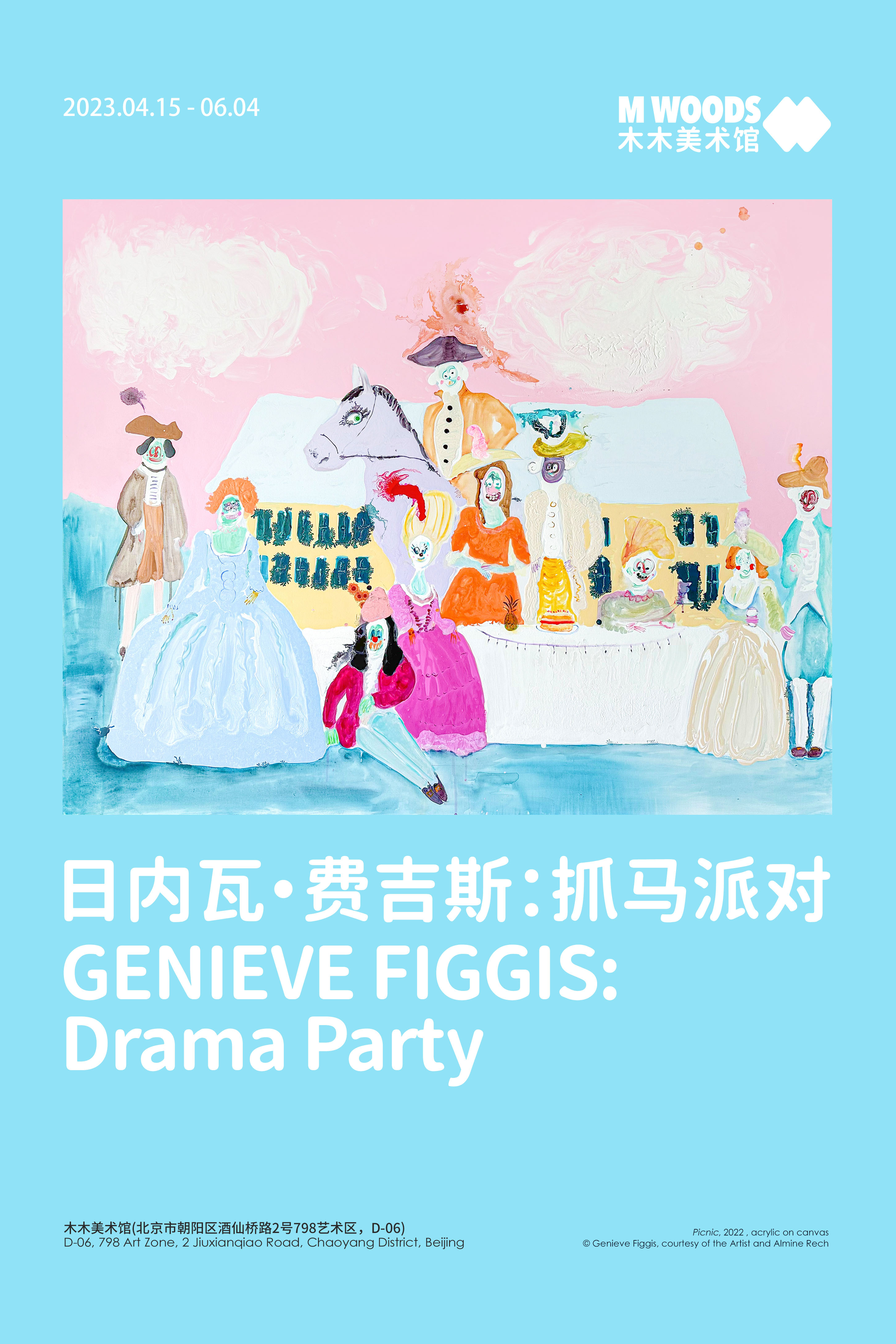
Genieve Figgis: Drama Party
15 April, 2023 – 4 June, 2023
M WOODS 798
Curated by Qi Yuanlin, Deng Yingying
"Painting is about pleasure. If it weren't pleasurable, I wouldn't do it."
- Genieve Figgis

Waiting, 2020, acrylic on canvas
© Genieve Figgis, Courtesy of the Artist and Almine Rech
Photo: Melissa Castro Duarte
1. Why did you choose “Drama Party” to be the title of your exhibition at M WOODS?
Drama Party is the title for the show because it sums up what the characters are doing in the works. I enjoy looking at people. In life, in movies and in magazines and it's nice to see how others live. You can find inspiration in life and by looking around at other people.
Growing up in Ireland in our family home, there always seemed to be some kind of drama going on or an important event happening. It was a busy creative home with my mother and father making furniture, frames, clocks. They grew flowers and vegetables, built extensions, a greenhouse, and fixed numerous cars. It was a busy environment.
I attended drama classes three times a week and we put on performances; we created plays. Gathering materials and rehearsing lines for a play, practicing story telling. I had a toy typewriter that I drafted little stories on to read in school the next day, made the covers for the books with my drawing and coloring pencils. On Sundays we attended Mass and prepared costumes and crafts for the ceremony. Everything was in preparation for some performance that was unfolding.
 Wedding, 2022, acrylic on panel
Wedding, 2022, acrylic on panel© Genieve Figgis, Courtesy of the Artist and Almine Rech
Photo: Nicolas Brasseur
2. In your works, you often depict scenes of royals or aristocrats enjoying courtly leisure in their sumptuous mansions and reimagine paintings by Old Masters who were court painters, such as Boucher and Goya. What make you attracted to these scenes or paintings?
The royals and aristocrats in my painting are just like everyone else. They do, however, have much better costumes and work a bit harder in their environment. I find them fascinating to watch. The historic reimagining of paintings is another way of experiencing the making and feeling how it would be to be allowed to perform as a court painter like Goya and Velesquez for example. History paintings are very other worldly they give us a tiny glimpse of the past dramas.

Green Bathroom, 2023, acrylic on canvas
© Genieve Figgis, Courtesy of the Artist and Almine Rech
3. The characters in your paintings often appear as ghost-like, which imbue a sense of mystery and uncanniness but also absurdity and comicality to the light-hearted leisure scene. Could you tell us more about your way of depicting the figures? And does this tension shown in your paintings contain some satirical or critical or deconstructive meanings that indicate the life of our times?
The figures in the paintings are made with very watered-down acrylic paint. I like them to be loose and free to move in an animate way like in a film. The painting allows me the freedom to place the characters into the work and dress them up to perform. They sometimes move and become animated as if in a movie. I also like the freedom that this displays rather than being focused on a traditional method which would focus on perfection or defining lifelike features. For me, this way is much more interesting because I cannot know the outcome, I can only watch the character unfold. Sometimes I start with a drawing and then pour on the paint and sometimes I divide the canvas up into a space like theatre where something interesting might happen.
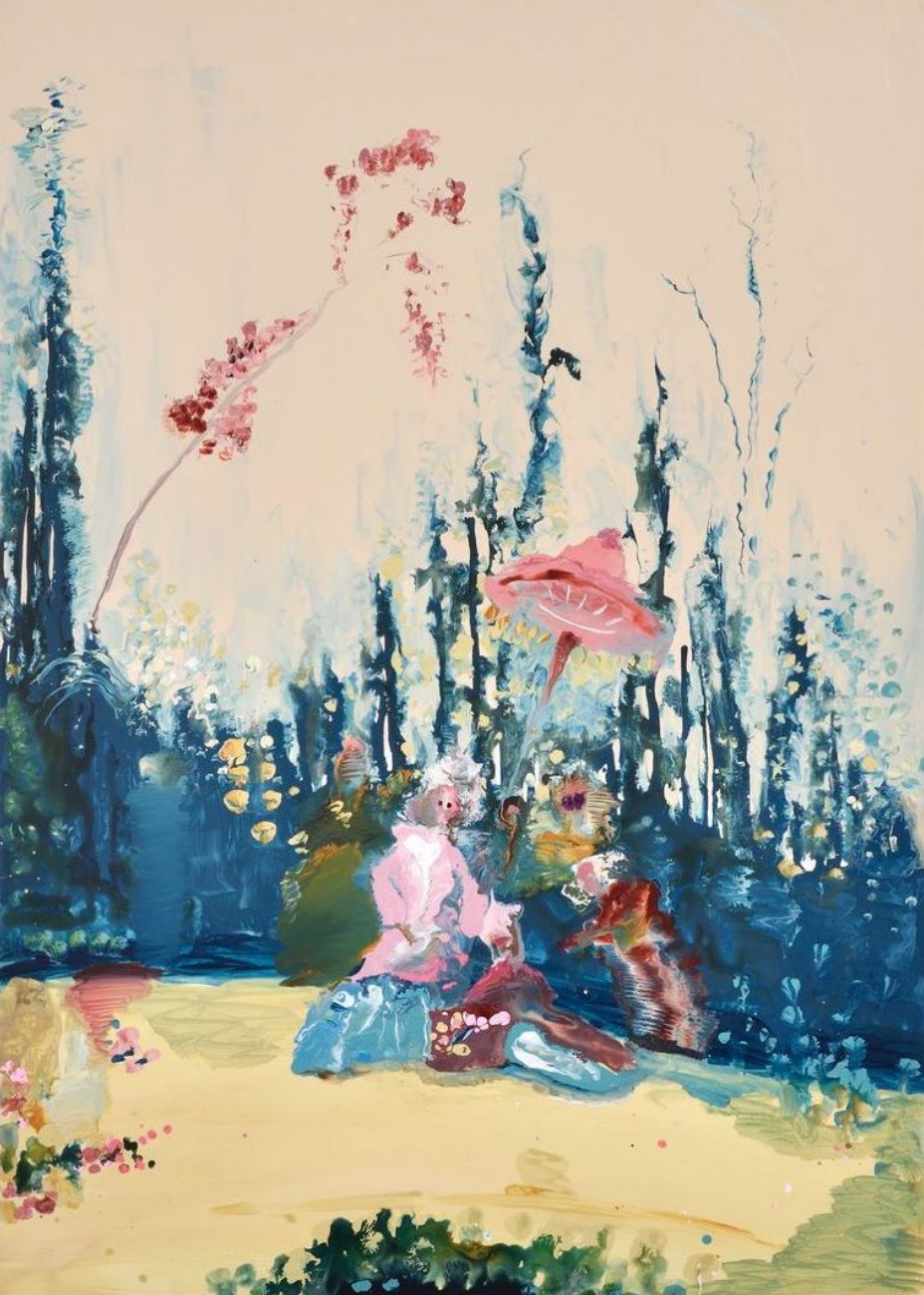
Flower Sellers after Boucher, 2019, acrylic on canvas
© Genieve Figgis, Courtesy of the Artist and Almine Rech
4. What are the sources of inspirations for your works?
Some of these paintings were made using images that I have collected over time, characters from TV programmes or couples who like to dress up and perform. Old vintage photographs are also some of my favourite images to work from. I don’t necessarily know who these people are. Sometimes with vintage photographs I can feel the potential to find out more and expand on the narrative of them, they feel inspiring and by working with them I can fill in the gaps. The way in which I work allows me to retell the story and fill in some more details. This feels like a very relaxing thing for me to do and it is something I enjoy very much, and, in a way, it is quite like fictional writing. The reason I find myself observing vintage photographs is because I do not know my own history. It will remain a mystery. My mother was born in 1940s Dublin and was handed over into an Orphanage. The unknown has followed us everywhere. It leers and makes us feel a bit lost in the world. Life is a mystery we need to figure out why we are here and what to do.

Halloween Nuts, 2022, acrylic on canvas
© Genieve Figgis, Courtesy of the Artist and Almine Rech
5. You mentioned that these images are only used as starting points and enjoy having freedom and unpredictability in your work without too much pre-planning or pre-conception. Could you tell us more about your creative process?
I feel that the process of when we are working on a painting or any kind of creative act, there is this free state to be found. That wonderful feeling of being in absolute freedom, it feels otherworldly and sometimes I look and wonder how it was even made. I look back and see myself in the work, but it feels unplanned and undirected.
Ireland has a dark past where great power was given to the catholic church. They found women to be of lesser value and worth. Women were not encouraged to be free and I feel like they were not encouraged to have ideas or have opinions. I work against this idea quietly in my own world. There is real freedom to be found in painting. It has its own secret language. Working with paint that flows freely allows me to work with this unique energy. The image unfolding surprises me reveling humor and darkness eventually giving way to the completion of a work, drying, and holding still and the image that is then seen but the process is what really interests me most.

Up the Blue Stairs, 2017, acrylic on wood panel
© Genieve Figgis, Courtesy of the Artist and Almine Rech
6. Do you think if the sense of humor, mystery and spirituality shown in your work have anything to do with your Irish upbringing?
The energy remaining in the aftermath of colonial rule and under a strict catholic upbringing is something that has been unique to the Irish experience. Our humor has sustained us through our darkest times.
The spirit world was part of daily conversation. People believed in spirits. There was on one hand a conversation about the all-seeing God who was watching us. In our daily lives, the conversation was about the holy spirt, lamb of God, body of Christ, holy Mary, Saints and Martyrs, Sinners and Heaven and Hell and some place called Limbo. A place where you would be sent as punishment after your life where you can be judged. A deprivation of eternal life after. The catholic theology conjured up all sorts of images in my imagination. There are many characters who are suspended on clouds, floating in the void of uncertainty. Sometimes you will notice similarities in my work where figures are suspended but look quite joyful and conveniently reveling their own stage performance. A sort of rebellion in a way.
There was also the dead and deceased who were always with us, never wanting to leave us and watching. There would be talk of door handles twisting to open of their own accord, footsteps on the creaky floor bords. An ancestor visiting to warn us of something to watch out for. The recently deceased hanging around where you could still hear them breathing in the room. Lightbulbs exploding in a room on our way to a funeral. Three knocks on the door before someone was about to die. Hearing a Banshee scream a warning before a death were all normal every day-to-day conversation.

Cult (Large), 2015, acrylic on canvas
© Genieve Figgis, Courtesy of the Artist and Almine Rech
Photo: Rebecca Fanuele

Formal Day Out, 2019, acrylic on canvas
© Genieve Figgis, Courtesy of the Artist and Almine Rech
7. The exhibition features works from different periods of your career, including your early works painted in 2014-16 as well as your most recent creations. Looking back over the past decade, is there any particular period of transition or predicament in your practice that you would like to share with us?
It is a strange feeling to look back at the work that I have done over the last ten years or more. I feel a better understanding from this point in relation to what was happening in my life. In a way that I can only describe in images I try to retell a story using the painting. I have always used my work as a surviving mechanism and a way to communicate more efficiently. It is a gentler way of conversing and a universal way to communicate to our fellow humans the understanding of how it feels to exist in this world.

Grace, 2021, acrylic on canvas
© Genieve Figgis, Courtesy of the Artist and Almine Rech
Photo: Rebecca Fanuele
8. Several new works made this year are shown to the public for the first time and we noticed that, especially by juxtaposing Hunting Party made in 2018 and 2023 opposite to each other in the gallery, the distorted and melting contours of figures have become clearer, and the swirling brush strokes and fluid pigment have turned into flat fields of color. Is that something that you’ve been experimenting with recently?
The figures are fascinating to me in Hunting party. I really do love and enjoy looking at the clothing and performance undertaken for a day out hunting. It is a drama about to unfold where they are getting ready to go out and kill for pleasure. It is all about their joy of being seen dressed up in their finest attire and having all the equipment and being seen in the act of about to go and destroy nature. In the act of painting them I feel a sense of fascination, the attention to fine detail of dress and clothing. The range of greens and muddy browns, shiny leather and metal barrels, fluffy dogs, and bright red lipstick. The figures from 2018 are larger and floaty and newer ones are more intimate and casual. I attempt to recreate the image to gain more understanding of the same drama.

Golden Throne, 2016, acrylic on canvas
© Genieve Figgis, Courtesy of the Artist and Almine Rech
9. How do you see yourself as a female artist? You started your family and became a wife and mother early in your life and now a grandmother. Have these roles influenced your work or how you perceive art in any way?
I have always seen myself as equal a not anyway different to a male or a male artist. I am sure however my experiences of growing up in Ireland may have attempted to make me feel of lesser value and the stories I tell will be about strong female characters reflected in my work.
Getting married was an escape route. The only doorway to freedom I could find. I was incredibly young and had no college degree or qualification. My husband was the same and we had common ideals about self-improvement and supported each other's escape to a better future. The journey that we are on is colored with family and animals. We each have our own identity and personal interests. I am glad that I have my family and have the space to engage and make art which is what I love to do. Making art is a wonderful thing to do but it is also nice to spend time with family and enjoy life.

The Seance, 2018, acrylic on canvas
© Genieve Figgis, Courtesy of the Artist and Almine Rech
10. Does your portrayal of female figure distinct from that of the male ones in your paintings, especially in your group portrait scenes?
Everyone is equal in my world that I attempt to create. Humans are funny and vulnerable, and I understand this. I watch from a far and participate in a quite observational manner. Not painting directly from life in a realistic way. I never focus on likeness or flattery as that would interfere with my process. I place a distance between me and my subject matter by instead focusing on the personality of what it is to be human.
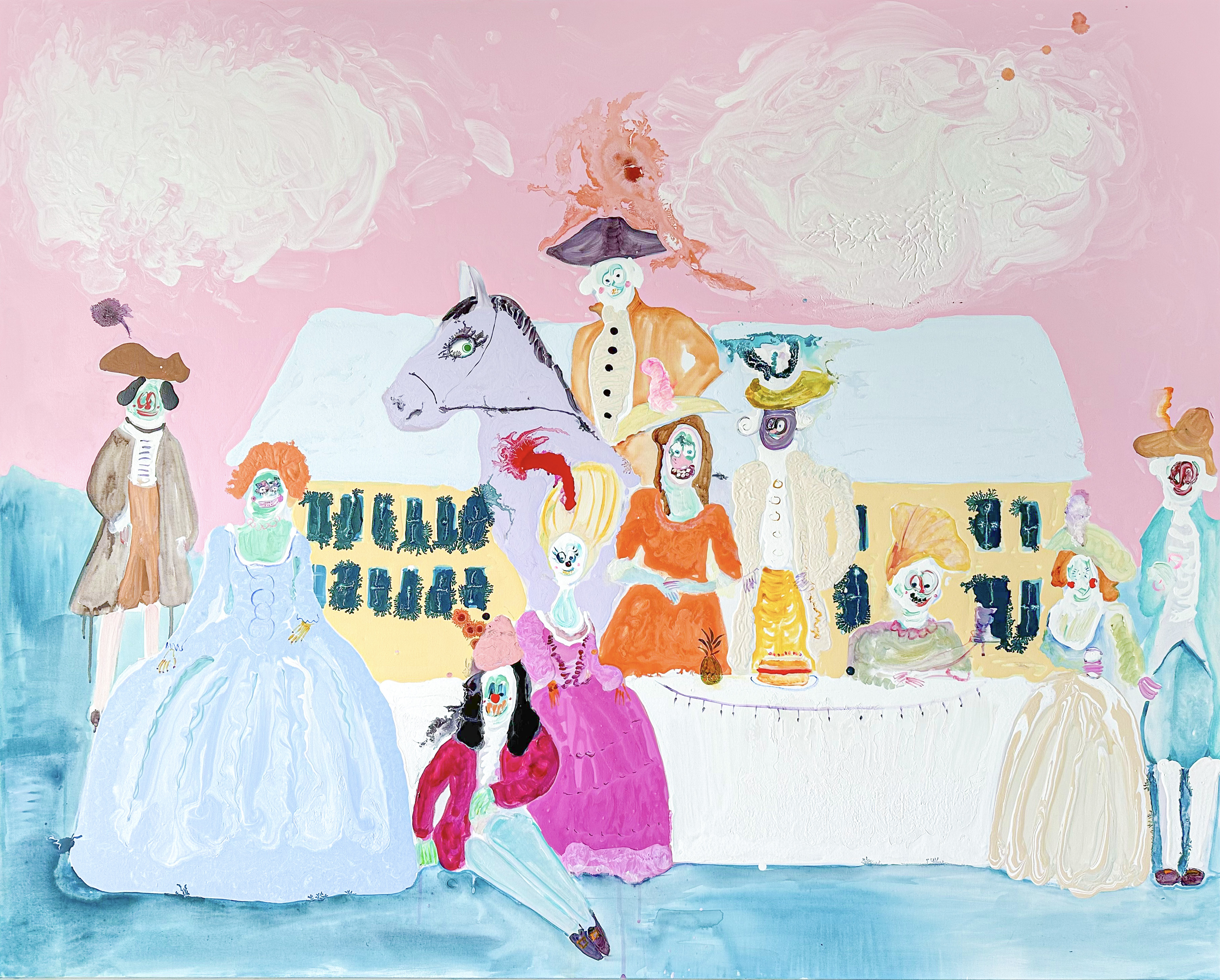
Picnic, 2022, acrylic on canvas
© Genieve Figgis, Courtesy of the Artist and Almine Rech
11. In your paintings, dogs, cats and horses often appear side by side with people. Is the inclusion of them in portraits more a way of expressing class and power or do you tend to them similar to your human characters?
I have always loved animals. They share the world with us, and I feel happy to include them in the paintings. The two dogs that I currently have are at the studio with me all day. Animals make the world a happier place; they are good company. During the pandemic we were all told to stay indoors, and we had time to reflect and understand how important nature was to us all and how good it is for our mental wellbeing.
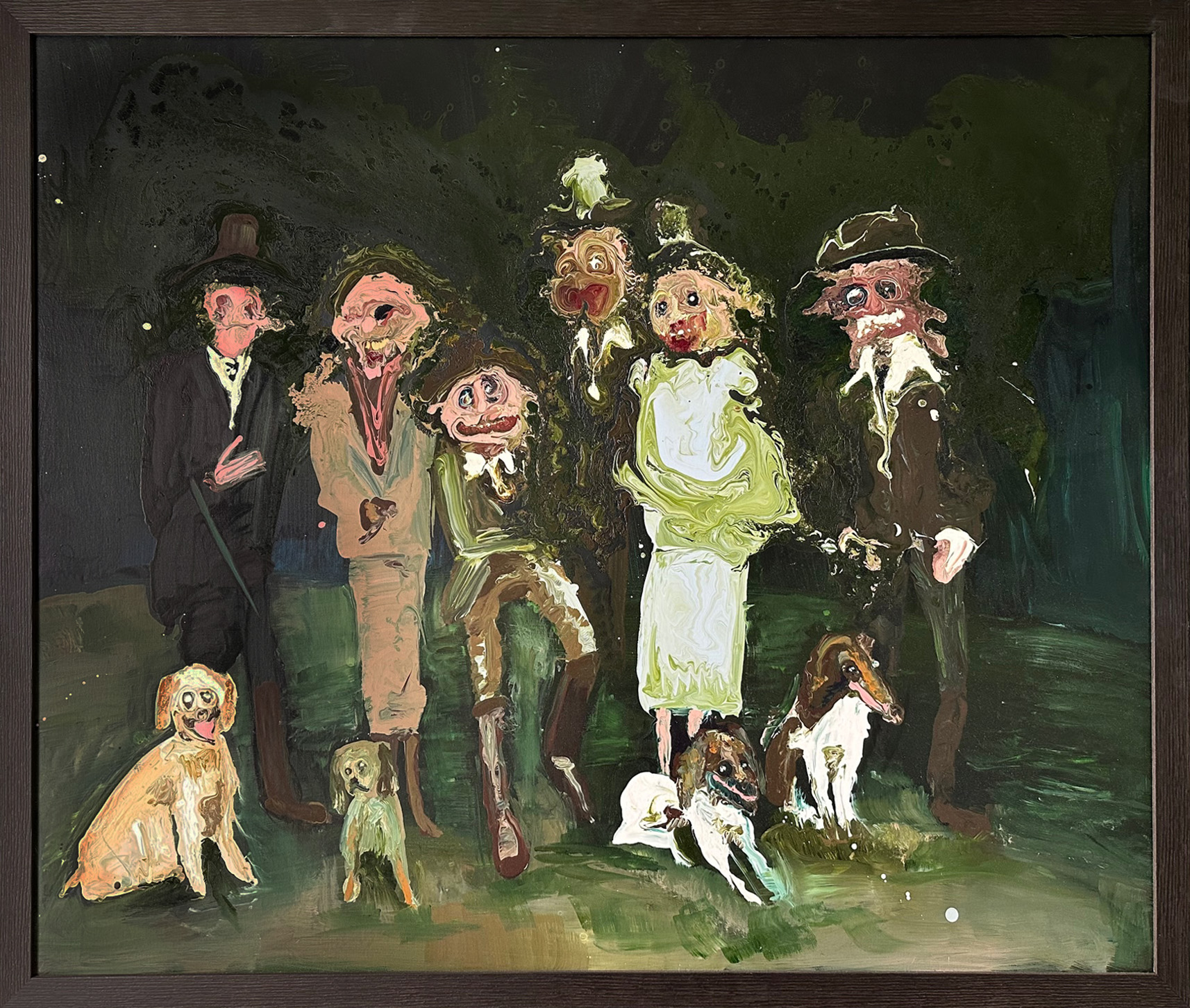
Hunting Party, 2018, acrylic on panel
© Genieve Figgis, Courtesy of the Artist and Almine Rech
12. In your work, the British royal family has been a recurring subject, such as The Crown (2022), William and Kate’s Wedding (2020) and Queenie (2020). We noticed that you recently post a painting of a crowned dog on King Charles III’s coronation day on your Instagram. Have you watched the coronation of King Charles III and will it become your sources of creation in the future? Could you tell us more about your interest in the British royal family?
The Royal family has always been in my work. In Ireland they feature in most of our magazines and daily newspapers. The painters I have admired in history were court painters. (I am an unofficial portrait painter) I have given myself permission and it feels exciting to do the opposite of what people expect. I get asked about this a lot, but I do not see any difference between anything that I paint. I work with all that I see and surrounds me. I recorded the Coronation on the television but have not had the chance to watch it yet. I have seen photographs and short clips online and observed body language and facial expressions. I cannot imagine ever having to be in a situation and public performance. I get the feeling that it is not a choice. It would not be my choice.
The pastel drawing, I posted on my Instagram page on Coronation Day, looks like that one guest we all know who arrives at someone else's party and wants all the attention. She is my little studio chihuahua who is 9 years old in June. She shares a birthday with Henry VIII, and she is the boss lady here. She knows she is beautiful and so do I.
I was fascinated to learn about the Tudors after I left school because it had never been mentioned. It was hidden from the school curriculum. I could not believe my eyes when I discovered the costumes and then later in relation to Holbein portraits at The National Gallery and The Tudor series filmed locally, only up the road to my studio. I wondered why it was hidden and I was obsessed with the costumes and characters.
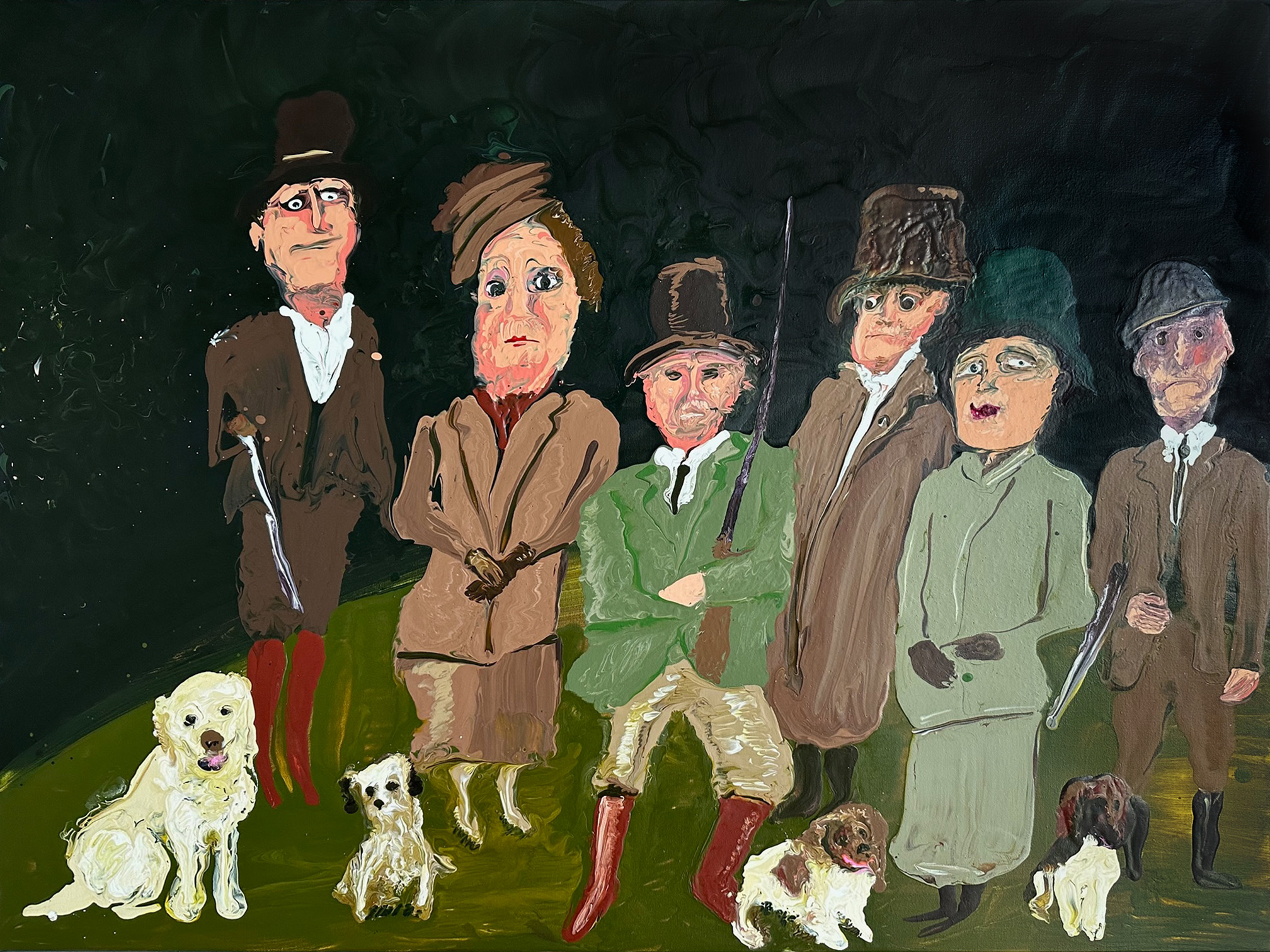
Hunting Party, 2023, acrylic on canvas
© Genieve Figgis, Courtesy of the Artist and Almine Rech
13. How do you see the relationship between art and technology? Since you were first discovered on social media by Richard Prince and you often share images of your works on Instagram. What role do you think social media or technology play in your creative practice or art in general, and in your own life?
I was sharing my work on Twitter back in 2012 and Richard Prince asked could be buy a painting. He is currently the biggest collector of my work. I am incredibly grateful to Richard for all the support he has given me over the years. He really is a good person; I love his work and I am a fan of everything he does.
In the early days I was sharing online because I wanted to reach out and share with the world what I was making. I wanted to connect with other people, and I did not need any permission. I felt free to share what I was making. I feel the same way these days and am grateful for the audience who connects with the work.
About the Artist

Portrait of Genieve Figgis, 2021
© Genieve Figgis, Courtesy of the Artist and Almine Rech
Photo: Doreen Kilfeather
Genieve Figgis was born in 1972 in Dublin, Ireland and currently lives and works in County Wicklow, Ireland. She received an MFA from the National College of Art and Design, Dublin in 2012. Figgis’ work has been featured in numerous exhibitions and projects in art institutions such as MoMu, Antwerp; Irish Museum of Modern Art (IMMA), Dublin; National Museum of Ireland, Dublin; Consortium Museum, Dijon, France; Aishti Foundation, Lebanon; and the Met Opera, New York City, NY. Her work is in the permanent collections of the Bass Museum of Art, Miami, US; Aishti Foundation, Beirut, Lebanon; Pérez Art Museum, Miami, USA; Smart Museum of Art, Chicago, USA and so on.
